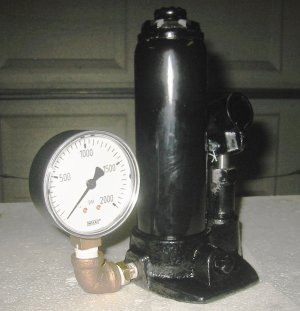- Joined
- Jul 7, 2012
- Messages
- 641
I hesitate call this a project because there's so little machining involved (drill two holes and tap a thread), but I figured it might be of interest to anyone else who needs to measure the tongue weight of their trailer, which is important when moving that mill, grinder, lathe, or in my case a 10K lb boat.
The pic makes the title pretty self explanatory, a $12 Wal-Mart 2 ton bottle jack, a $4 gauge (eBay), and $4 in brass fittings and jack oil, then twenty minutes to complete it.
The procedure is to first disassemble the jack by unscrewing the cap complete with piston while keeping the base clamped in a vise.
Discard the oil along with all the carp floating in it, then clean everything up taking care not to damage the piston seal or any of the 'O' rings.
Next, drill an 1/8" hole horizontally into the base from outside, followed by a similar one vertically to intersect it inside after unscrewing the cylinder bore.
Open the first 3/4" of the horizontal hole to 21/64" and tap it 1/8"-27 NPT which will probably be the size of fitting you step down to.
Finally, measure the piston head diameter before cleanup, reassembly, and filling with fresh oil.
Now all that needs to be done is to calculate the area of the piston head (pi * r squared) in order to be able to apply a correction factor to the psi reading from the gauge (mine was 0.7), and not only do you have a tongue gauge, but you also have a dedicated trailer jack as well!
To broaden the scope slightly, the same technique can be used to adapt a press, or floor or pallet jack to display their loading too.

M

The pic makes the title pretty self explanatory, a $12 Wal-Mart 2 ton bottle jack, a $4 gauge (eBay), and $4 in brass fittings and jack oil, then twenty minutes to complete it.
The procedure is to first disassemble the jack by unscrewing the cap complete with piston while keeping the base clamped in a vise.
Discard the oil along with all the carp floating in it, then clean everything up taking care not to damage the piston seal or any of the 'O' rings.
Next, drill an 1/8" hole horizontally into the base from outside, followed by a similar one vertically to intersect it inside after unscrewing the cylinder bore.
Open the first 3/4" of the horizontal hole to 21/64" and tap it 1/8"-27 NPT which will probably be the size of fitting you step down to.
Finally, measure the piston head diameter before cleanup, reassembly, and filling with fresh oil.
Now all that needs to be done is to calculate the area of the piston head (pi * r squared) in order to be able to apply a correction factor to the psi reading from the gauge (mine was 0.7), and not only do you have a tongue gauge, but you also have a dedicated trailer jack as well!
To broaden the scope slightly, the same technique can be used to adapt a press, or floor or pallet jack to display their loading too.

M


